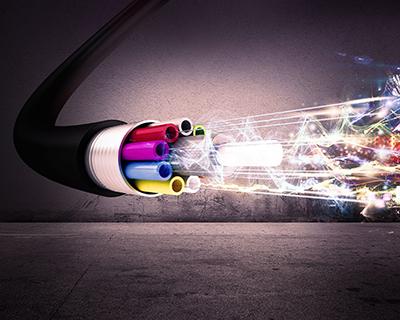Updated: February 28, 2024
While many factors are involved in satisfactory internet service (the connection technology used, the latency rate, etc.), many consumers often look first and foremost at the speed. How fast is the connection?
With this entry, we’re considering a fundamental measure of modern internet speed—the Mbps (megabit(s) per second). What is Mbps? What is a megabit? What Mbps rating will most effectively suit your online needs? How do you decide?
Deeper into the Megabit
To answer the question, what is Mbps, it’s important to know what a megabit is. To explain, we’ll start by removing “mega,” leaving a lowly “bit”—the smallest measure of digital information. In the internet’s early days, bps or “bits per second” quickly became insufficient for describing and tracking the thousands of bits involved in communication between networked devices. As a result, connection speeds began being measured in “kilobits per second.” A kilobit is simply a thousand bits.
As connections grew ever faster, the kilobit became insufficient, too, and gave way to the megabit. A megabit is 1,000 kilobits, amounting to 1,000,000 total bits. As technology continues advancing, the megabit is slowly giving ground to the gigabit, which is 1,000 megabits or 1,000,000,000 total bits. Although more internet plans will be measured in Gbps as technology continues evolving, for now, most are still measured in Mbps.
Megabits Vs. Megabytes
In considering the megabit, some readers may be more or equally familiar with the “megabyte(s).” The two concepts are related but used in specialized ways. While a megabit expresses the speed at which data is delivered over a connection, a megabyte describes the total amount of data transferred over that connection—the amount that reaches the end-users device. So what is Mbps then? It’s simply a measure of how many megabits per second can be passed over an internet connection.

Speed Matters – But Not as Much as You Might Think
With internet service, it’s easy to fall into a “more is better” mindset. Admittedly, a 300 Mbps connection should, in theory, deliver more data than a 200 Mbps connection. However, depending on how you use internet service and how many devices/users connect in your household, the real-world difference between a 300 and 200 Mbps connection—or even a 50 Mbps connection—may be negligible or imperceptible.
When you’re shopping for service, ask yourself, “How do I use the internet in my household? How many family members do I have? How many connected devices are there in regular use?” When considering this last question, be sure to include any smart thermostats, appliances, etc., that connect and often remain continuously connected to the internet.
How Much Speed Do I Need?
Here are some general numbers to consider when answering this question.
Streaming Video
Do you regularly stream internet video from services like Netflix, Amazon Prime, Disney+ and others?
Maintaining a stable, buffer-free stream in low-definition (240p or lower) requires 1.5 Mbps. Standard definition (480i/480p) requires 3 Mbps. To stream in high definition (1080i/1080p), you’ll need at least 5 Mbps. Ultra HD streaming (2160p) requires at least 25 Mbps.
Streaming Music
Do you use music streaming apps like Spotify, Amazon Music, Apple Music and others? For uninterrupted playback at maximum quality, these services general require 2 Mbps.
Video Games
Do you have a gamer in the family? Whether they prefer console or PC gaming, online play requires anywhere between 2 and 10 Mbps. That’s a wide range, but modern video games vary widely in complexity, interactivity and size. Online gaming requires a fairly low latency rate, too; for more on that, visit our blog on latency.
Email and Web Browsing
For satisfactory email use and web browsing, users need between 0.5 and 5 Mbps. This large variation is related to the email service used (e.g., Gmail, Yahoo Mail, etc.) and the type of sites visited in a browser. For example, if a user streams video through a browser (on YouTube.com, for instance), they’ll need more Mbps than if they browse headlines in a news aggregator (e.g., Yahoo.com, MSN.com, etc.). The number of advertisements on visited sites also matters, as does the number of videos that play automatically at page load.
Video Calls
To maintain stable, clear connections via live video chat, users need between 0.5 Mbps for standard resolution and 1.5 Mbps for HD.
Large File Downloads
With anywhere between 5 and 50 Mbps, users can expect generally dependable downloads of large files. The difference lies in how long downloads take. Of course, file size is an important factor, but the slower the connection, the longer the download time.
More Users = More Need for Speed
It’s important to remember that all these estimates are for a single user/device. For example, if you’ve got a TV in the bedroom and one in the living room streaming standard definition video simultaneously, you’d need to multiply 3 Mbps by two, equaling a baseline of 6 Mbps for stable, buffer-free entertainment on both devices. If you’ve got five users in the same home simultaneously streaming music from Spotify, multiply by five for a 10 Mbps base speed. And neither of these examples account for any additional users or any constantly connected smart devices.
GVEC Internet Fiber’s Got it all Covered
Looking for fast, dependable internet that’s “up to speed” with your family’s active lifestyle? GVEC Internet Fiber delivers the world’s fastest internet technology, with speeds up to 1 Gbps. Plus, download and upload speeds are identical with GVEC Internet Fiber, and latency times are near zero, creating stable, glitch-free experiences no matter what you do online. For more information, call 800-699-4832. To find out if Fiber is available in your neighborhood or when it might be coming, visit the GVEC Internet Internet Availability Map.

